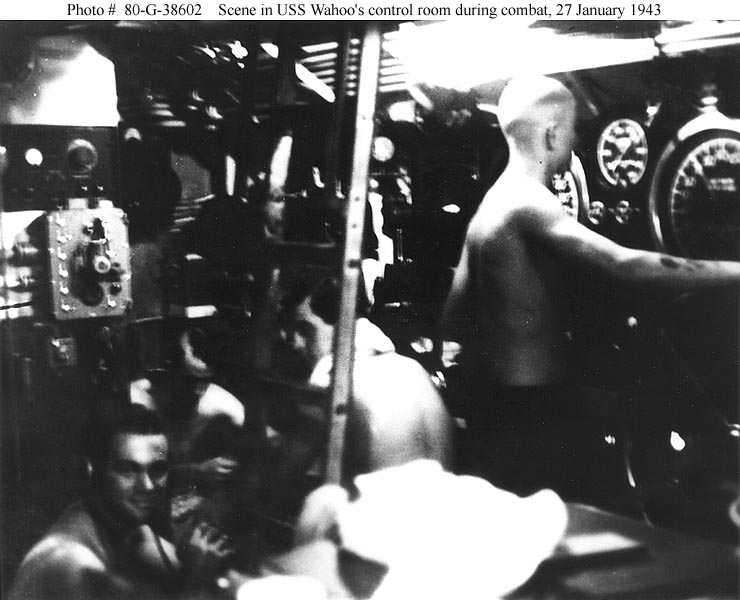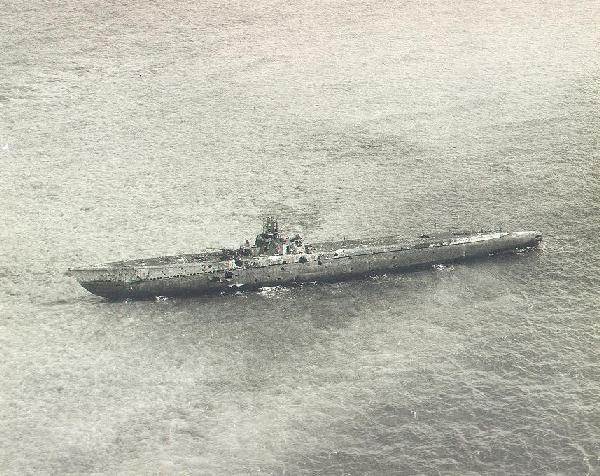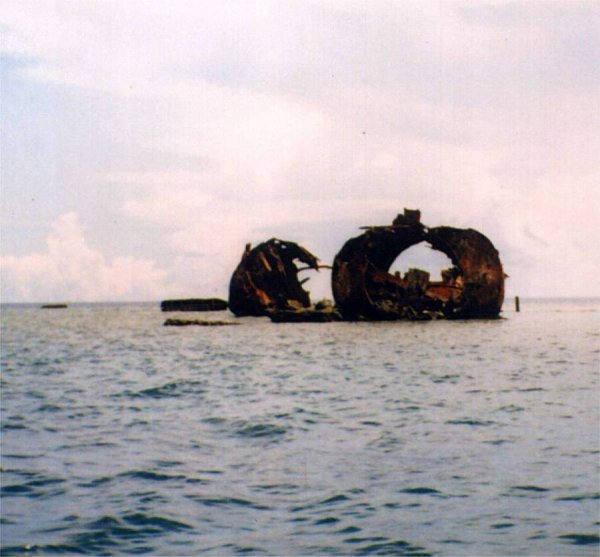On being depth charged:
Quote:
|
You were scared as hell! It felt like being inside a steel drum while someone banged on it. There wasn't much anybody could do except wait in unbearable heat and try to think of other things. The air got foul, and there was nothing to duck behind, no defense but stand and wait for something to happen. If the destroyer had sonar, when you heard the ping you knew he had a fix on you. It was a helpless feeling. The unwritten code said you could be frightened but you weren't supposed to show it ... but there were a lot of white knuckles during those attacks. You didn't feel much like talking, but there was a lot of praying. I was scared and anyone who tells you they weren't is lying.
|

Quote:
|
We dove as deep as we could ... our (depth) range was 300 feet ... and went on silent running. During silent running, all machines, pumps, blowers and so forth were shut down and the bulkheads secured. Talking was kept to a minimum, and only then in hushed tones. You also wanted to avoid dropping any loud objects. It was then up to the captain to get us out. When an enemy destroyer charged in for the attack, it came in fast so it could get out of the way of depth-charge explosions, but the high speed meant that he couldn't hear us move as well. The captain would try to guess the destroyer's approach, then move the submarine out of the attack path when he thought the destroyer could not detect any sound because of high speed and churning waters. It became a guessing game, like two swords dueling in the dark. There was a cat-and-mouse aspect to it.
|
One of the more incredible incidences of the pacific submarine war, deals with the immortal phrase, "Taker her down!" At 0100, On 7 February USS Growler ( Howard W. Gilmore commanding) stealthily approached a gunboat for a night surface attack. The small fast ship suddenly turned to ram. Unable to avoid the collision, Gilmore ordered left full rudder and all ahead flank, and rammed the enemy amidships at 17 knots.
As machine gun fire raked them at point-blank range, Commander Gilmore ordered the bridge cleared. As the commanding officer, Gilmore was the last to leave the bridge, and was grievously wounded before he could get below. Realizing that he was jeopardizing his boat's escape, he ordered "Take her down!" and shut the hatch, remaining on the bridge while his boat dived. By saving his command at the expense of his own life, Commander Gilmore became one of the six submariners to earn the Medal of Honor. (A seaman and another officer also lost their lives in this incident).
Severely damaged but still under control, Growler returned to Brisbane under command of her exec.
Since the pacific submarine war was won, with far fewer casualties then what was inflicted upon the germans in the atlantic, most assume that the pacific was a cakewalk shooting gallery. This simply isn't true. While the japanese ASW strategy was indeed lacking strategically, tactically, the empire of Japan had some formidible captains who made good on opportunity. The US Submarine service comprised of only 1.6 percent of all US Naval personnel in the Pacific; yet 1 out of every 5 US submariners would lose their lives.
But the Japanese wasn't the only threat to look out for, reefs and shoals are plenty in the pacific where waters are shallow in many areas as the USS Darter found out the hard way:

Here is what remains of the USS darter today, she never did get herself off that reef:

What the pacific theater lacked in scale of submarine operations, it more then made up for in intensity. The overall impact that the United States Navy's submarine forces had on the outcome of the war in the Pacific is often understated. To study the Pacific theater without looking closely at the battle figures compiled by the Silent Service would be a grave injustice to any student of the war and to the valiant men who unselfishly gave of themselves. Comprising less then 1.6% of all US Naval personnel in the Pacific, yet accounting for more then half of all enemy shipping sunk.
Historians have stated that a major factor contributing to Japan's surrender was this island nation's recognition of the fact that she was unable to sustain the war effort due to the severe shortages of raw materials and basic essentials. By eliminating their ability to import vital goods and supplies, American submarines were able to do to Japan what Hitler's U-Boat force came close to doing to England.
In the words of Winston Churchill, "Never has so much been owed by so many to so few." Approximately 244 submarines from the Porpoise class to the Balao class were comissioned between 1930, and 1945, and served during WW2. The US submarine service sustained the highest mortality rate of all branches of the U.S. Military with a total of 52 United States submarines lost, and 1 in 5 submariners losing their lives. 3,505 American submariners are on eternal patrol.
The story of the Pacific submarine theater, and the Silent Service is one that is often missed, or passed by. With no blockbuster style movie to generate interest, the deeds , valor and heroism, of this theater often go by unsung and unnoticed, and fades from the public conciousness. To the last, the silent service in WW2 lives up to its moniker. The study of the pacific theater, the essence of it all, the spirit, the romance, isn't summed up by any movie like Das Boat, but by a simple poem written by a man who was there.
The poem is called, "The Trigger Maru", and it embodies everything that the pacific theater was about.
( I should note that this is in no way meant to a reference or a plug, for the mod of the same name) It was written by a crew member aboard the USS Trigger. While it was meant to tell about the tale of a single boat, it infact tells the tale of the pacific submarine war.
Quote:
I'm the galloping ghost of the Japanese coast.
You don't hear of me and my crew
But just ask any man off the coast of Japan.
If he knows of the Trigger Maru.
I look sleek and slender alongside my tender.
With others like me at my side,
But we'll tell you a story of battle and glory,
As enemy waters we ride.
I've been stuck on a rock, felt the depth charge's shock,
Been north to a place called Attu,
and I've sunk me two freighters atop the equator
Hot work, but the sea was cold blue.
I've cruised close inshore and carried the war
to the Empire Island Honshu,
While they wire Yokahama I could see Fujiyama,
So I stayed, to admire the view.
When we rigged to run silently, deeply I dived,
And within me the heat was terrific.
My men pouring sweat, silent and yet
Cursed me and the whole damned Pacific.
Then destroyers came sounding and depth charges pounding
My submarine crew took the test.
Far in that far off land there are no friends on hand,
To answer a call of distress.
I was blasted and shaken (some damage I be taken),
my hull bleeds and pipe lines do, too
I've come in from out there for machinery repair,
And a rest for me and my crew.
I got by on cool nerve and in silence I served,
Though I took some hard knocks in return,
One propeller shaft sprung and my battery's done,
But the enemy ships I saw burn.
I'm the galloping ghost of the Japanese coast,
You don't hear of me and my crew.
But just ask any man off the coast of Japan,
If he knows of the Trigger Maru.
|